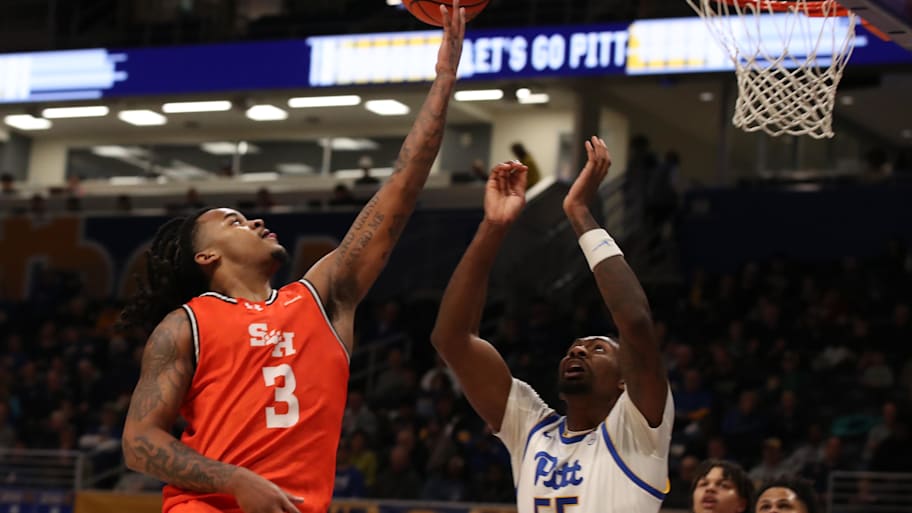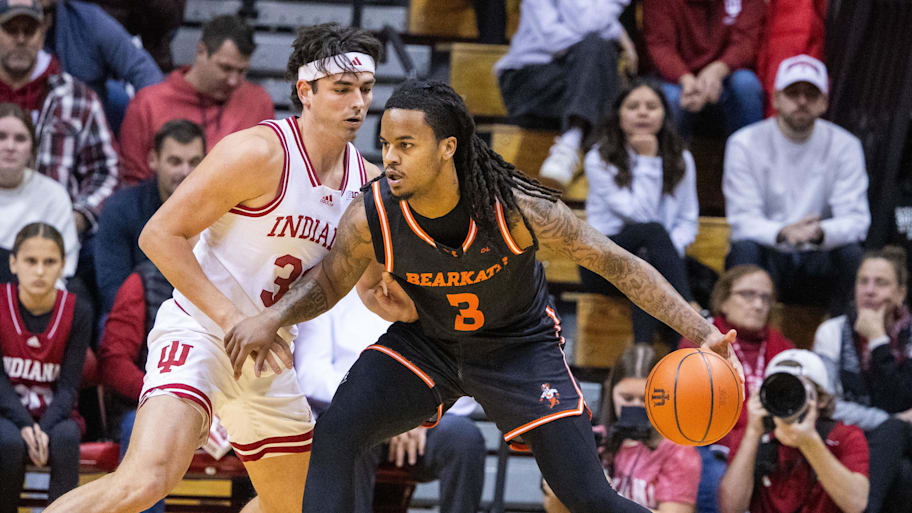After being one of the top earners in the transfer portal this spring, new Indiana guard Lamar Wilkerson found a way to give back to the program that helped him develop into a star.
Wilkerson revealed in an interview with Jeff Goodman and Rob Dauster of Field of 68 Thursday that he donated some of his NIL earnings back to Sam Houston State. SHSU head coach Chris Mudge wouldn’t reveal the exact amount to Sports Illustrated, but confirmed the donation was a six-figure gift, which was given to the Bearkats program to use however it saw fit.
According to Mudge, it was Wilkerson’s idea and came up before he even picked a new school.
“He just brought that idea to us and said, ‘Coach, I’m always a Bearkat and I appreciate everything you’ve done for me. I’d like to do this to help out the program so you can keep being successful,’” Mudge recalls.
“I did it out of love for Coach Mudge, for Sam Houston,” Wilkerson said in the Field of 68 interview. “I had been there for three years. It was home for me. I got comfortable there. I built a family with a lot of people, a lot of donors. I just gave back because I feel like I want to see their program [thrive], I want to see them get better over time.”
Wilkerson has one of the most compelling rags-to-riches stories in all of college athletics. After decommitting from a Division II school following a coaching change, Wilkerson wasn’t sure if he’d even play college basketball and went to work at a Husqvarna factory in Arkansas, building chain saws, lawn mowers and leaf blowers. After a month, he got an opportunity through a friend to play junior college basketball at Three Rivers College in Missouri and spent two years there before getting his Division I shot at Sam Houston State. He upped his scoring average from 7.4 points per game his first year to 20.5 in his third at SHSU, which would have been his final year of eligibility if not for the court case involving Vanderbilt quarterback Diego Pavia that gave former junior college athletes eligibility for 2025–26.
Once armed with that extra year, Wilkerson was quickly one of the most in-demand players in the country, flooded with interest from the top schools in the country before the season had even ended or he had put his name in the portal. Despite all the interest, Wilkerson never played with one foot out the door. Mudge even recalls at one point in the season Wilkerson coming into his office to discuss how the program could rebuild for 2025–26.
“I was like, ‘Whoa, whoa, whoa, whoa, you’re not coming back,’” Mudge says. “And not because I didn’t want him to, that would be phenomenal, but that shows his loyalty … Lamar has earned the ability to get life-changing money for him and his family.”
Once Wilkerson hit the portal, he visited Kentucky before picking Indiana, where he’ll be a centerpiece of new head coach Darian DeVries’s first team in Bloomington. He received an NIL/revenue-share package that sources have indicated is north of $2 million.

The generosity from Wilkerson, in some ways, models a system that some mid-major coaches have spoken about wanting to implement in the sport moving forward as unlimited transfers take hold and the gap between mid- and high-major programs widens financially. In many European soccer leagues, the club that sells the rights to a player receives a transfer fee that makes their investment in developing the player worthwhile and helps fund a replacement. Many coaches have privately (and in some cases publicly) expressed their desire for a similar system for college players who transfer up, rewarding schools that successfully develop young players into stars and helping those schools rebuild their rosters after losing all-conference players to the highest levels of the sport.
Few coaches would expect or even ask a player to take matters into their own hands the way Wilkerson did. But the idea of a school like Indiana that shelled out around $10 million to build its roster this spring having to kick back some cash to programs like Sam Houston State, Troy and North Florida whose rosters it raided might have some merit. It could help level the playing field at a time in which there’s concern about mid-majors remaining competitive after a chalky NCAA tournament in 2025.
Mudge isn’t sure how such a system would work, at least without larger structural changes to player contracts and perhaps even collective bargaining. And there isn’t much incentive for the “haves” in the current system to push for a change that costs them money. But even if a transfer fee system doesn’t catch on, schools are already hunting for ways in new revenue-sharing contracts to protect themselves from losing top talent. SI has learned of multiple programs at all levels of Division I offering high school recruits two-year contracts this fall as the recruiting period for 2026 high school graduates heats up.
Don’t expect many players to voluntarily part with their cash though. That takes a special person like Wilkerson with a sense of loyalty to a place that molded him, even on his way out the door.
“Lamar is unique and one of one in his own way,” Mudge says. “He certainly sets a really high bar for what we want our guys to be and a great example of that in absolutely every way.”
More College Basketball on Sports Illustrated
This article was originally published on www.si.com as In a Changing College Game, Lamar Wilkerson Starts New Trend.
